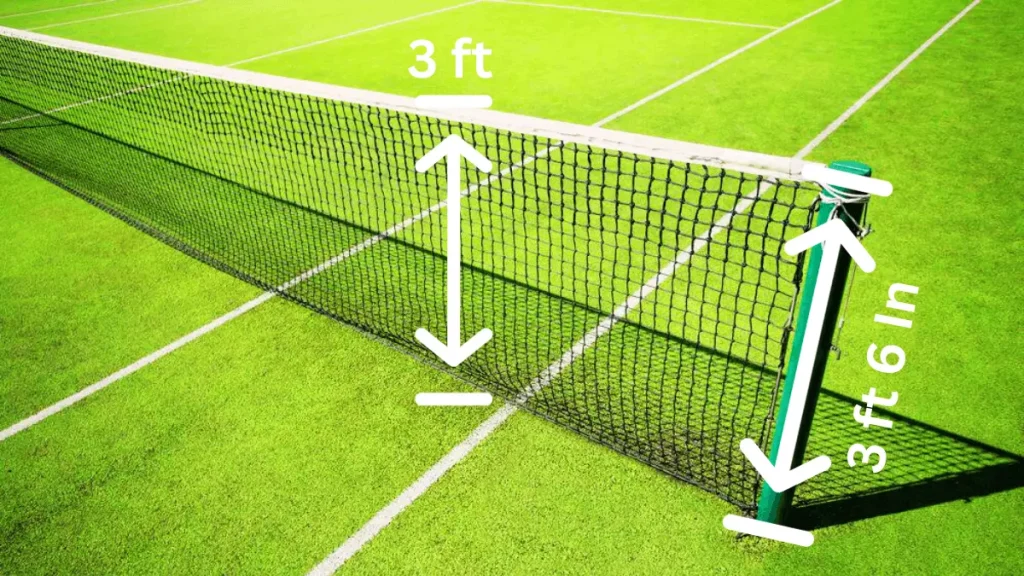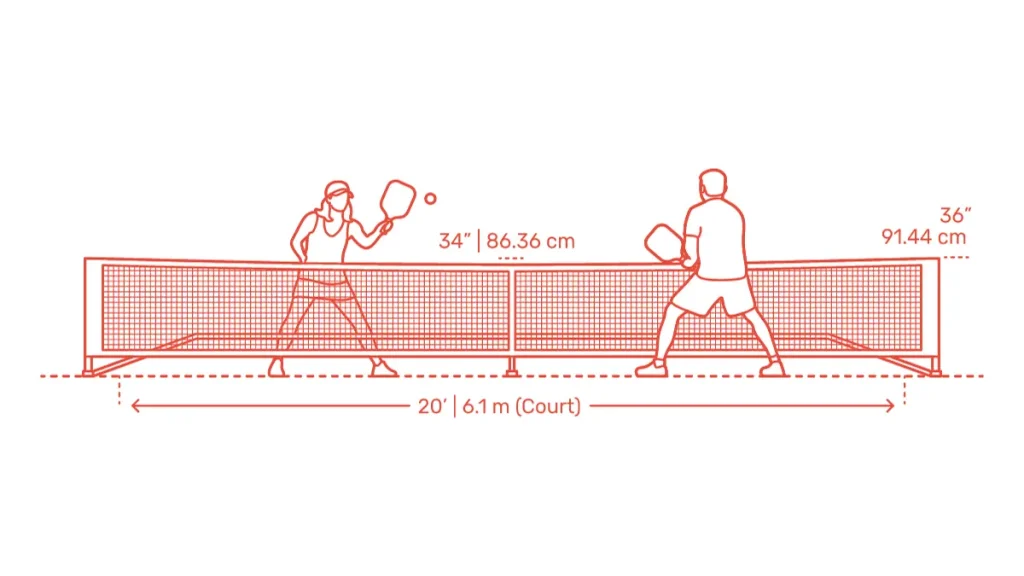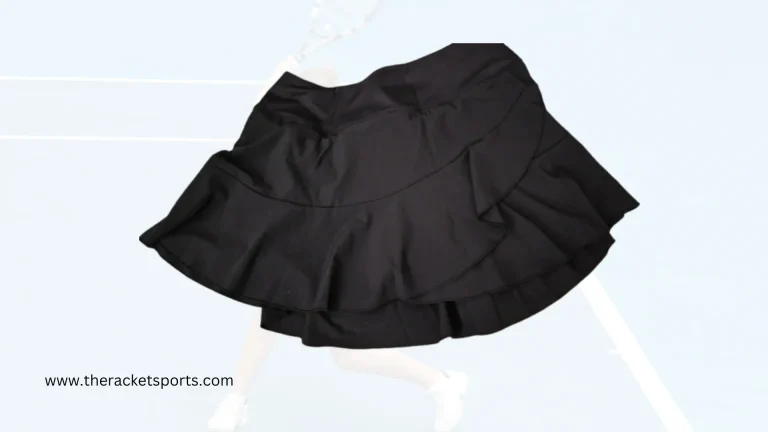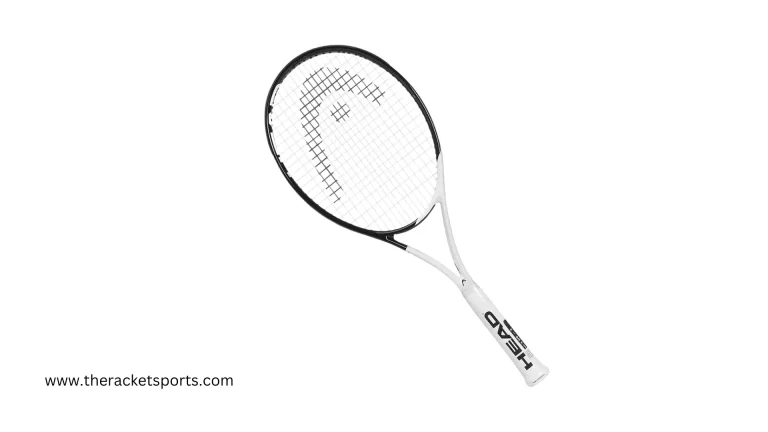Tennis Net Height – Know The Exact Measurements 2025
Ever seen players play cross-court shots and increase rally time? The answer to that strategy is in the tennis net’s height. It’s not just about the players themselves; the tennis net also plays a big part.
That seemingly simple piece of net actually has a huge impact on how the game unfolds.
The Standard tennis net height is at 42 inches at the posts and 36 inches at the center. These ITF Tennis net height regulations are your blueprint for crafting the perfect court setup.

In this article, we’re going to break down the tennis net dimensions in detail. We’ll cover everything from how high it should be at the posts to the dip in the middle.
But don’t worry! this isn’t a dry rulebook; think of it as a guide to enhance your tennis skills. Whether you’re a pro or just starting out, understanding the ins and outs of the net can help you. Read further to see how you can use net height to level up your skills in tennis.
ITF Tennis Net Official Measurements
To know the official tennis net height, you need to know all of its key elements. You’ll need two net posts, a metal cable, a white strap, and a white band. Now, let’s explore the official measurements according to the International Tennis Federation (ITF) for a net that meets tournament standards.
- The Right Height
Start with the net posts at a height of 42 inches (107 cm) on either side of the court. At the center, set a net height of 36 inches (91.4 cm). These measurements aren’t just numbers; they’re the official tennis net heights for tournaments. All tournaments follow this.
- Strap It Right
To secure the net’s central position, use a white strap that is no wider than 2 inches (5 cm). This strap makes sure the net’s middle part is visible for players to see.
- Grounded Band
Have you ever wondered why the net in a tennis game stays tight and in the right position? There’s a band connected to the ground, pulling down the middle of the net. This helps it stretch across the gap between the two posts. And your tennis net middle will stay low.
When setting a Tennis net on the court, just follow these ITF guidelines. Confused? Just see the table for a quick understating of the different measurements of the tennis net’s height:
Tennis Net Height For Singles
| Height | At Net Centre | At Net Posts |
|---|---|---|
| Feet | 3 feet | 3.5 feet (3’6’’) |
| Centimetre | 91.4 cm | 107 cm |
| Meter | 0.914 m | 1.07 m |
| Inches | 36 inches | 42 inches |
Tennis Net Height For Doubles
In doubles tennis, the net height remains the same as in singles. But the net posts must be positioned 36 inches outside the doubles court on each side. Here’s why:
- Doubles vs. Singles
First things first, the court size isn’t the same in doubles and singles tennis. For singles, the court width spans 324 inches, while doubles players have a wider area of 432 inches. The net height stays the same, but the net post position changes.
- Net Placement Precision
In doubles matches, the positioning of the net posts is crucial. The centers of those net posts should be 36 inches (91 cm) beyond the doubles court boundaries on both sides. A tip: make sure the net posts and sticks are not bigger than 6 inches by 3 inches. Also, they shouldn’t stick out more than 1 inch above the net cord.
Tennis Net Height For Juniors
Tennis for junior players involves different net heights as they progress through divisions. There are four divisions: Red, Orange, Green, and Yellow. In the Red Division (8 years and under), the net height is shorter (2’9’’).
As they advance to the Orange Division, the net height becomes standard at 3 feet 6 inches. This standard height is maintained in both the Green and Yellow Divisions.
Just to make it easy for you, here’s a quick table summarising the net heights at each junior stage:
| Height | Stage Red (8 and under) | Stage Orange, Green, Yellow |
|---|---|---|
| Centimetre | 83.82 cm | 107 cm (91.4 cm at centre) |
| Meter | 0.8382 m | 1.07 m (0.91 m at centre) |
| Inches | 33 inches | 42 inches (36 inches at center) |
| Feet | 2.75 feet (2’9’’) | 3.5 feet (3’6’’) (3’ at center) |
The Reason Behind Lowered Height in the Middle
Once the net is up, a center strap gives it an extra pull-down. Now, this is necessary as it adds a unique element to the game. Hitting over the net in the middle becomes easier, creating a distinct strategy.
Now, let’s dive into tactics! Lowering the net in the middle isn’t a random thing; it’s a smart move to make the game more exciting. It’s like a strategic choice, like the corner three in basketball.
The lower middle encourages longer rallies, and we, as players, give a more entertaining game. Shots like cross-court in the middle are thanks to this dip!
How Tennis Net Height Impacts Serve And Volley
Why Do You Need to Know About the Tennis Net’s Height? In tennis, the net is a big deal. It can either help you ace the game or cause a defeat in it. A slightly touched net can change how the game goes, affecting rallies and attacks. Without the net, tennis wouldn’t be as exciting.

- Safe and Easy Shots Strategy
If you want an easier shot, go crosscourt. This is when you hit the ball diagonally. It’s safer because the net is lower, giving you less room for error.
- Down-the-Line Shots:
Hitting straight down the line is more challenging. There’s a smaller chance for success, and the net is higher on the sides. But if you pull it off, you can surprise your opponent and score big points.
- Flat Serves:
When serving, consider the net’s height. If you’re going for a strong, flat serve, aim for the middle (“T”). This strategy increases the chances of a successful serve, especially in high-pressure situations.
- Slice Serves:
Many players use slice serves to move opponents around, but a slice down the middle works, too. It adds some extra height, increasing the chances of a successful serve.
Comparing Tennis Net Heights to Other Sports
Three sports are similar to tennis, and they all have different net heights. Tennis nets are taller on the sides and higher in the center than padel tennis nets. Whereas, Beach tennis nets are even higher and have the same height on the sides and in the middle.
Understanding these differences adds an extra layer of insight for players. This is great for players who are transitioning between sports or simply exploring the diverse world of racket sports. Here’s all you need to know:
- Pickleball Net Height:
Pickleball has become really popular lately, attracting both tennis fans and new players. If you’re switching from tennis to pickleball, it’s important to know that pickleball nets are a bit shorter than tennis nets.

According to the USA Pickleball Association (USAPA), the sides of a tennis net are six inches higher than a pickleball net, and the center is only two inches higher. So, the net on a pickleball court is 36 inches high on the sidelines and 34 inches high in the middle.
- Padel Net Heights:
Padel tennis, also called platform tennis, is similar to pickleball but has its own rules. In paddle tennis, according to the American Platform Tennis Association’s rules, the net height is not the same as in tennis or pickleball. The net is a bit lower in the middle compared to many racquet sports. It has a height of 34.6 inches (0.88 meters) in the middle and 36 inches (0.92 meters) on the sides.
- Beach Tennis Net Heights
Beach tennis is a new sport similar to regular tennis, but the main difference is the net height. In traditional tennis, the net is lower compared to beach tennis. The beach tennis net is consistently higher (1.7m to 1.85m) across the court. This sets it apart from regular tennis and padel tennis, where net heights vary between sides and center.
Final Words
Overall, understanding the net’s height can make a big difference in your game. Every detail, from the center dip to the net posts in doubles, plays a role. It affects your choices, strategy, and, ultimately, your success on the court.
We’ve even compared net heights to other racket sports for broadening your perspective.
Whether you’re perfecting a crosscourt shot or switching between racket sports, the net height is important. So, the next time you are on the court, the net isn’t just a barrier; use it to win!
Faqs
How can I measure the height of a tennis net?
It’s simple! Grab a measuring tape, go to the center, where you will find a white band, and measure up and down. Alternatively, use measuring sticks or mark your racket to measure. We recommend keeping tape in your bag, just in case.
How do I adjust the height of a tennis net?
It’s Easy! Pull below or above the metal buckle to lower or raise the net. It’s at the center where the white straps are. Quality straps work best; weather can affect them, so adjust regularly. If needed, look for a reel at the post or contact local authorities for help.
Is the tennis net lower in wheelchair tennis?
No changes! Wheelchair tennis uses the same court dimensions and net height as conventional tennis, with standard balls and rackets.
Is the tennis net lower in women’s tennis?
No! Both men and women play with a standard net height of 42 inches at the posts and 36 inches at the center.
What’s the size of a tennis court?
A standard tennis court is 78 ft x 36 ft, totaling 2,808 sq ft. For singles matches, it’s narrower at 78 ft x 27 ft or 2,106 sq ft.








Very great post. I just stumbled upon your blog and wanted
to mention that I’ve truly enjoyed browsing your weblog posts.
After all I’ll be subscribing in your rss feed and I am hoping you write again very soon!
Hurrah! After all I got a web site from where I be able to in fact get valuable data regarding my study and knowledge.
Everything is very open with a clear clarification of the issues.
It was definitely informative. Your site is very helpful.
Thank you for sharing!